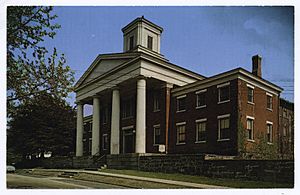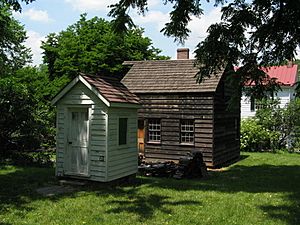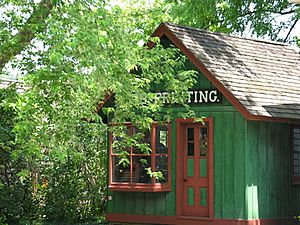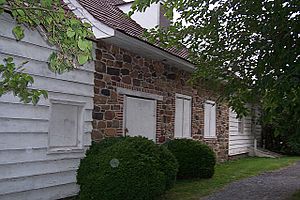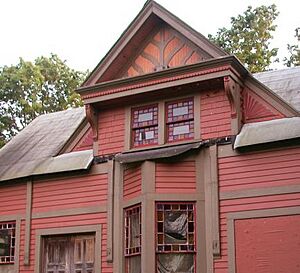Historic Richmond Town facts for kids
Historic Richmond Town is a special museum village and farm on Staten Island, New York City. It's located in the neighborhood of Richmondtown, right in the middle of the island. The Staten Island Historical Society helps run this amazing place.
This museum has over 30 old buildings and sites. They show what life was like from the late 1600s to the early 1900s. Decker Farm, a short distance away, offers fun seasonal activities like pumpkin picking. Many buildings, including homes and shops, were moved here from other parts of Staten Island.
Richmond Town got its name in the early 1700s. It used to be the main town and business center for Richmond County. This county is the same as Staten Island today. People living here were often from Dutch, English, or French families. They worked as blacksmiths, shoemakers, and other skilled craftspeople. During the American Revolution, British soldiers stayed in Richmond Town. It was a strong base for people who supported the British, known as Loyalists.
Contents
Discovering Historic Richmond Town's Past
How Historic Richmond Town Began
Creating Historic Richmond Town took a lot of effort from many Staten Islanders. Local historians like Loring McMillen and William T. Davis, along with banker David L. Decker, led the way. They were inspired by a passion for history during the Great Depression. This same passion also led to the creation of Colonial Williamsburg.
These people wanted to save Staten Island's rich history. They saw a lot of new buildings and growth happening. Historic Richmond Town was officially started in 1958. It's a team effort between the Staten Island Historical Society and New York City. The city owns the land and buildings. It also helps fund some of the museum's activities.
In June 2020, Laura Gentile became the president of the Staten Island Historical Society's board. She is the second woman to lead the organization in its 164-year history. Edna Hayes was the first, serving from 1978 to 1989.
Exploring the Museum Village Today
What You Can See at Historic Richmond Town
The main part of Historic Richmond Town covers about 25 acres. It's part of a larger 100-acre area. There are 15 restored buildings where you can experience life from 300 years ago. Two churches, St. Andrew's Episcopal and St. Patrick's Church, are near the museum site. A third church, the Reformed Dutch Church of Richmond, was taken down. Mount Richmond Cemetery is also next to the site.
Fun Activities and Exhibits
Step Back in Time with Historic Trades
Visitors to Historic Richmond Town can imagine what life was like in the 1800s. You can take guided tours of homes and shops. These buildings are fully furnished to show different time periods. Some buildings are still being fixed up and are not open yet.
While it's not a full-time living history museum anymore, you can still see demonstrations. Costumed interpreters show old trades, crafts, and daily household tasks. These happen during special events and for school groups.
Special Events and Programs
Historic Richmond Town hosts many fun events throughout the year. "Old Home Day" is the oldest event and features many traditional crafts. Other events include the Richmond County Fair, Oktoberfest, and Pumpkin Picking at Decker Farm in October. There are also Candlelight Tours and a Summer Apprenticeship Program. This program lets kids up to age 15 learn old trades like tinsmithing and cooking.
Important Historic Buildings
The Voorlezer's House, built around 1780, was once thought to be the oldest elementary school in the U.S. However, research in 2018 showed this wasn't true. Another interesting building is the Guyon-Lake-Tysen House, a Dutch Colonial farmhouse from about 1740.
The Christopher House, built around 1720, is being restored. It has the only working jambless fireplace in New York City. Many buildings here show beautiful Dutch Colonial and Greek Revival styles. These include The Stephens-Black House, the John Bennett House, The Britton Cottage, and the Treasure House.
In 1987, the Staten Island Historical Society moved the Jacob Crocheron farmhouse. It was built around 1819-1820 and moved over 3 miles from Annadale. The house even got traffic tickets during its journey, but they were later canceled!
Getting to Historic Richmond Town
How to Visit the Museum
You can reach Richmond Town by taking the S74, S54 buses.
See Also
- List of museums and cultural institutions in New York City
- List of Staten Island neighborhoods


